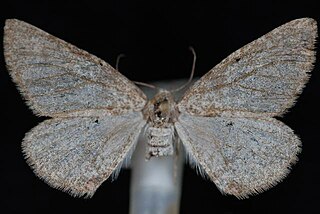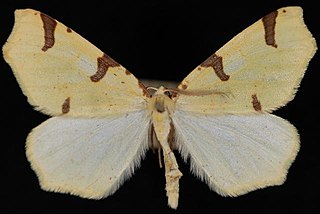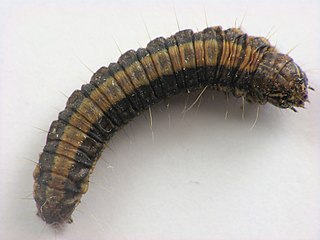
Though small in absolute diversity of genera, the Hemitheini are nonetheless the largest tribes of geometer moths in the subfamily Geometrinae. Like most Geometrinae, they are small greenish "emerald moths". The tribe was first described by Charles Théophile Bruand d'Uzelle in 1846.

Orthonama obstipata, the gem, is a moth of the family Geometridae. The species was first described by Johan Christian Fabricius in 1794. It is a cosmopolitan species. In continental Europe though in the northeast, its range does not significantly extend beyond the Baltic region and it is absent from northern Russia. This well-flying species is prone to vagrancy and able to cross considerable distances of open sea; it can thus be regularly found on the British Isles and even on Iceland.
Mycterophora is a genus of moths of the family Erebidae. The genus was erected by George Duryea Hulst in 1896.

Sigela is a genus of moths in the family Erebidae. The genus was erected by George Duryea Hulst in 1896.

Digrammia was a genus of moths in the family Geometridae erected by Carl Freiherr von Gumppenberg in 1887. It is now often considered a synonym of Semiothisa.
Ersephila is a genus of moths in the family Geometridae described by George Duryea Hulst in 1896.
Melemaea is a genus of moths in the family Geometridae described by George Duryea Hulst in 1896.

Meris is a genus of moths in the family Geometridae described by George Duryea Hulst in 1896.

Neoterpes is a genus of moths in the family Geometridae described by George Duryea Hulst in 1896.

Perizoma is a genus in the geometer moth family (Geometridae). It is the type genus of tribe Perizomini in subfamily Larentiinae. The tribe is considered monotypic by those who include the genera Gagitodes, Martania and Mesotype in Perizoma. Some other less closely related species formerly placed here are now elsewhere in the Larentiinae, e.g. in Entephria of the tribe Larentiini.
Pherne is a genus of moths in the family Geometridae described by George Duryea Hulst in 1896.

Spodolepis substriataria is a moth of the family Geometridae first described by George Duryea Hulst in 1896. It is found from Alaska to Nova Scotia, south in the east to New Jersey and in the west to California.
Stergamataea is a genus of moths in the family Geometridae first described by George Duryea Hulst in 1896.

Tetracis is a genus of moths in the family Geometridae erected by Achille Guenée in 1858.

Thallophaga is a genus of moths in the family Geometridae described by George Duryea Hulst in 1896.

Xanthorhoini is a tribe of geometer moths under subfamily Larentiinae. The tribe was described by Pierce in 1914.

The Epipaschiinae are a subfamily of snout moths. More than 720 species are known today, which are found mainly in the tropics and subtropics. Some occur in temperate regions, but the subfamily is apparently completely absent from Europe, at least as native species. A few Epipaschiinae are crop pests that may occasionally become economically significant.
Caberini is a tribe of geometrid moths in the family Geometridae. There are at least 50 described species in Caberini.

Zenophleps lignicolorata is a species of geometrid moth in the family Geometridae. It is found in North America.













